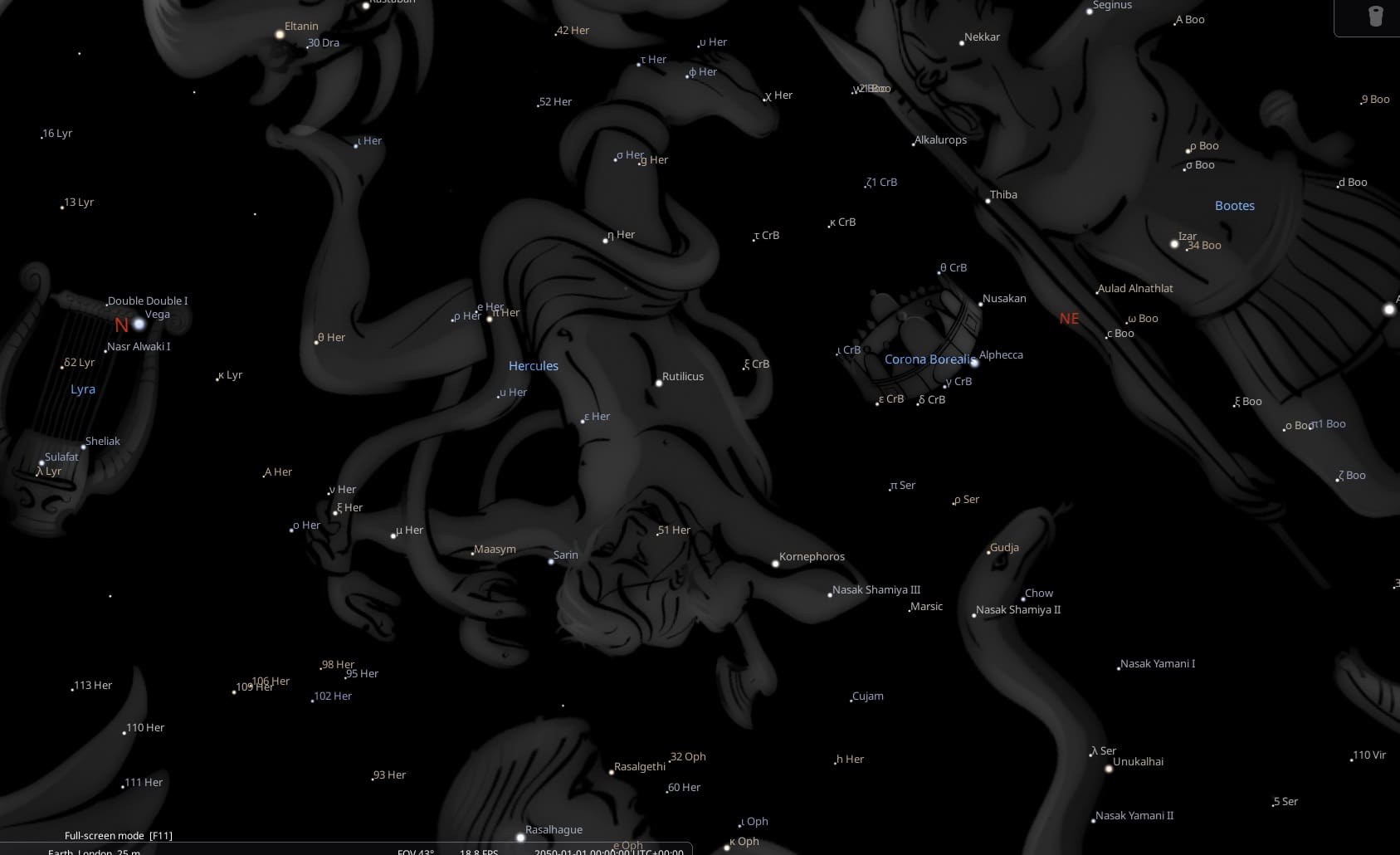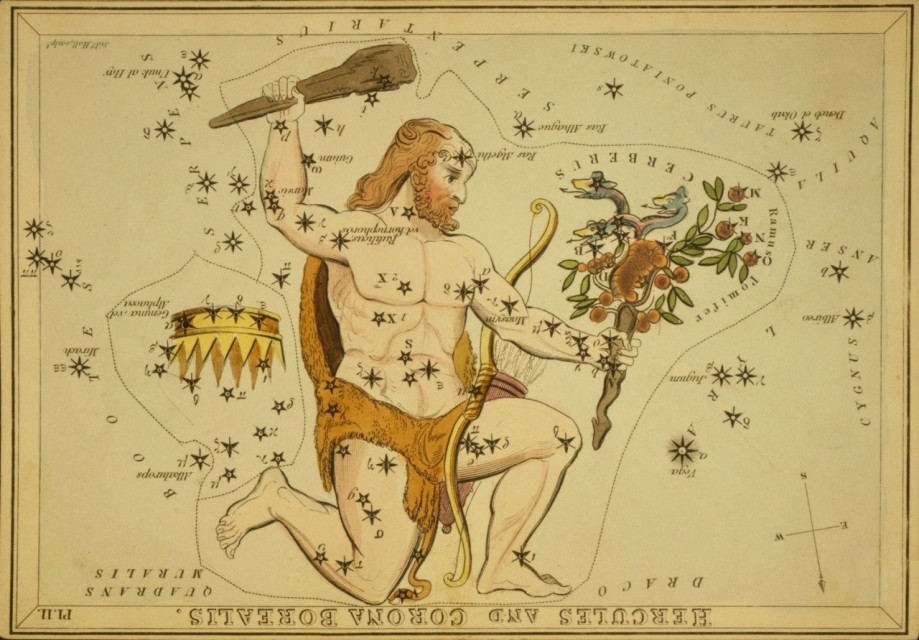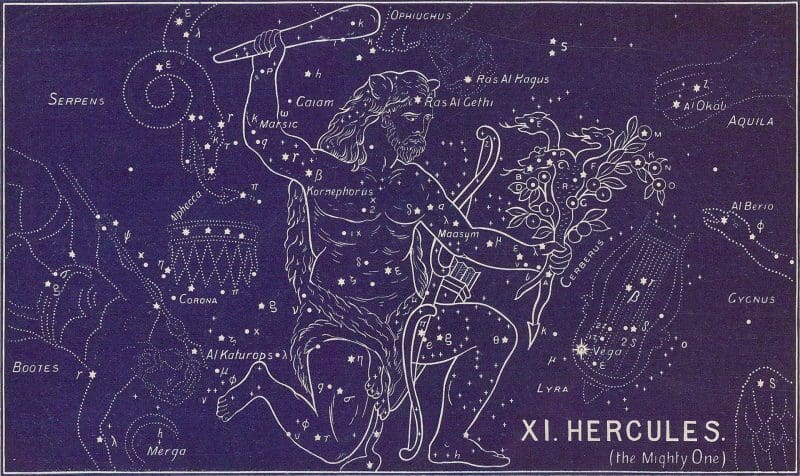FIXED STARS: Major Stars | 1000+ Stars | Constellations | About
Constellation Hercules, the Kneeling Man, is a northern constellation bordering Ophiuchus, Draco, Boötes, Lyra and the obsolete constellations Cerberus, Quadrans Muralis and Taurus Poniatovii.Hercules is one of the 48 constellations listed by Ptolemy in the 2nd century and remains one of the 88 modern constellations. It spans 50 degrees of the zodiac in the Signs of Scorpio, Sagittarius and Capricorn.
Abbreviation: Her
Genitive: Herculis
Hercules Constellation Stars
| 2000 | 2050 | Star | Name | Sp. Class | Mag. | Orb |
|---|---|---|---|---|---|---|
| 08♏14 | 08♏57 | χ Her | F9 | 4.60 | 1°00′ | |
| 14♏23 | 15♏05 | τ Her | Rukbalgethi Shemali | B5 | 3.91 | 1°30′ |
| 25♏43 | 26♏25 | κ Her | Marsic | G8 | 5.00 | 1°00′ |
| 27♏23 | 28♏05 | 16 Her | Hejian | K3 | 5.72 | 1°00′ |
| 28♏47 | 29♏30 | η Her | Sophian | G7 | 3.48 | 1°40′ |
| 29♏12 | 29♏55 | γ Her | Nasak Shamiya III | A9 | 3.74 | 1°30′ |
| 01♐05 | 01♐47 | β Her | Kornephoros | G8 | 2.78 | 2°00′ |
| 01♐27 | 02♐09 | ζ Her | Rutilicus | F9 | 2.81 | 2°00′ |
| 01♐34 | 02♐17 | ω Her | Cujam | B9 | 4.57 | 1°10′ |
| 08♐19 | 09♐01 | ε Her | A0 | 3.92 | 1°30′ | |
| 09♐15 | 09♐57 | 49 Her | Huàn Zhě | B9 | 6.51 | 1°00′ |
| 12♐03 | 12♐46 | π Her | Fudail | K3 | 3.16 | 1°50′ |
| 14♐45 | 15♐28 | δ Her | Sarin | A3 | 3.12 | 1°50′ |
| 15♐22 | 16♐04 | ρ Her | Nǚ Chuáng | B9 | 4.15 | 1°20′ |
| 16♐09 | 16♐51 | α Her | Rasalgethi | M5 | 3.31 | 1°40′ |
| 19♐52 | 20♐35 | ι Her | Fekhiz al Jathih al Aisrh | B3 | 3.82 | 1°30′ |
| 19♐54 | 20♐36 | λ Her | Maasym | K3 | 4.41 | 1°10′ |
| 25♐12 | 25♐55 | μ Her | Marfak Al Jathih Al Aisr | G5 | 3.42 | 1°40′ |
| 26♐09 | 26♐51 | 87 Her | Jiuhe | K2 | 5.09 | 1°00′ |
| 28♐28 | 29♐10 | θ Her | Rukbalgethi Genubi | K1 | 3.86 | 1°30′ |
| 29♐11 | 29♐53 | ξ Her | Beraka | K0 | 3.70 | 1°30′ |
| 01♑59 | 02♑41 | 98 Her | Tú Sì | M3 | 4.96 | 1°00′ |
| 02♑41 | 03♑23 | ο Her | Zhōngshān | B9 | 3.84 | 1°30′ |
| 14♑46 | 15♑28 | 110 Her | Zōng | F6 | 4.19 | 1°20′ |
| 18♑03 | 18♑45 | 113 Her | G4 | 4.57 | 1°10′ |
Hercules Astrology
Manulius
Hercules, the figure on bended knee and called by the Greek name of Engonasin, about whose origin no certainty prevails. Of this constellation is begotten the desertion, craftiness, and deceit characteristic of its children, and from it comes the thug who terrorizes the heart of the city. If perchance his mind is moved to consider a profession, Engonasin will inspire him with enthusiasm for risky callings, with danger the price, for which he will sell his talents: daring narrow steps on a path without thickness, he will plant firm feet on a horizontal tightrope; then, as he attempts an upward route to heaven, (on a sloping tightrope) he will all but lose his footing and, suspended in mid-air, he will keep a multitude in suspense upon himself.
Robson
Legend. This constellation was put in heaven as a reminder of the labors of Hercules. According to another account, however, during the war between the Gods and Titans the former all ran to one side of the heavens, which would have fallen had not Atlas and Hercules supported it, and the latter was placed in the sky in commemoration of this service.
Influences. According to Ptolemy it is like Mercury. It is said to give strength of character, tenacity and fixity of purpose, an ardent nature and dangerous passions. By the Kabalists it is associated with the Hebrew letter Daleth and the fourth Tarot Trump “The Emperor”.
Magical. Gives victory in war. [2]
Allen
Hercules stretching from just west of the head of Ophiuchus to Draco, its eastern border on the Milky Way, is one of the oldest sky figures, although not known to the first Greek astronomers under that name.. and some modern students of Euphratean mythology, associating the stars of Hercules and Draco with the sun-god Izhdubar and the dragon Tiamat, slain by him, think this Chaldaean myth the foundation of that of the classical Hercules and the Lernaean Hydra. Izhdubar is shown on a cylinder seal of 3000 to 3500 B.C., and described in that country’s records as resting upon one knee, with his foot upon the Dragon’s head, just as Aratos says of his Engonasi, and as we have it now.
His well-known adventures are supposed to refer to the sun’s passage through the twelve zodiacal signs, appearing thus on tablets of the 7th century before Christ. This myth of several thousand years’ antiquity may have been adopted by Greece, and the solar hero changed into Hercules with his twelve familiar labors.
Our stellar figure generally has been drawn with club and lion-skin, the left foot on Draco and the right near Boötes, the reversal of these by Aratos being criticized by Hipparchos; but the Farnese globe shows a young man, nude and kneeling; while the Leyden Manuscript very inappropriately drew it as a young boy, erect, with a short star-tipped shepherd’s crook, bearing a lion’s skin and head. Bayer shows the strong man kneeling, clothed in the lion’s skin, with his “all brazen” club and the Apple Branch. [3]
Bullinger
Here the mighty one, who occupies a large portion of the heavens, is seen bending on one knee, with his right heel lifted up as if it had been wounded, while his left foot is set directly over the head of the great dragon. In his right hand he wields a great club, and in his left hand he grasps a triple-headed monster (Cerberus). And he has the skin of a lion, which he has slain, thrown around him. (Cerberus, or the serpent with three heads, was placed by Hevelius (1611-1687) by the side of Hercules. Bayer had previously placed the apple branch in his hand. This was symbolical of the golden apples of Hesperides, which he obtained by killing this three-headed hydra, by whom they were guarded. In our picture these are combined, and a bow and quiver added from other ancient authorities.)
In the Zodiac of Denderah we have a human figure, likewise with a club. His name is Bau, which means who cometh, and is evidently intended for Him who cometh to crush the serpent’s head, and “destroy the works of the devil.” In Arabic he is called Al Giscale, the strong one.
There are 113 stars in this constellation. Seven are of the 3rd magnitude, seventeen of the 4th, etc. The brightest star, α (in his head), is named Ras al Gethi, and means the head of him who bruises. The next, β (in the right arm-pit, is named Kornephorus, and means the branch, kneeling. The star κ (in the right elbow) is called Marsic, the wounding. The star λ (in the upper part of the left arm) is named Ma’asyn, the sin-offering. While ω (in the lower part of the right arm) is Caiam, or Guiam, punishing; and in Arabic, treading under foot. [4]
References
- Astronomica, Manilius, 1st century AD, p. 353.
- Fixed Stars and Constellations in Astrology, Vivian E. Robson, 1923, pp. 46-47, 231.
- Star Names: Their Lore and Meaning, Richard H. Allen, 1889, pp. 238-246.
- The Witness of the Stars, E. W. Bullinger, 1893, Hercules (the Mighty Man).


